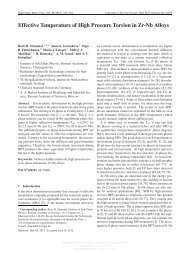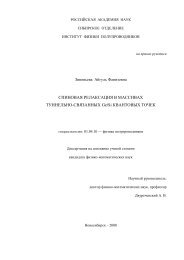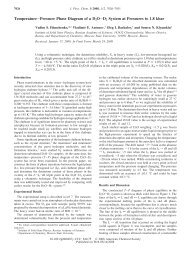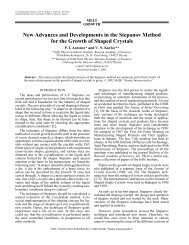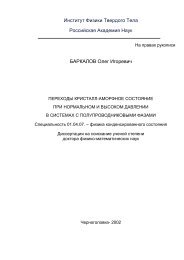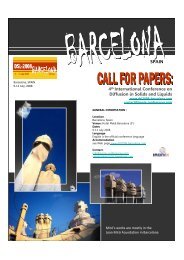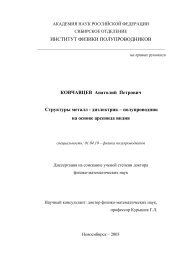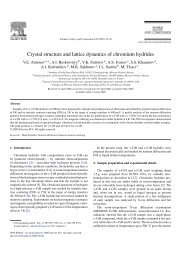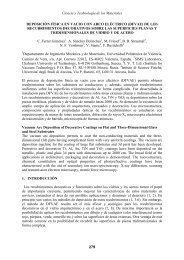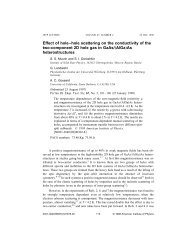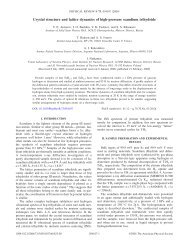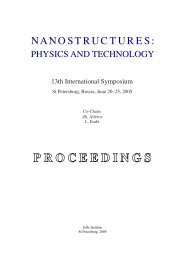Hydrides
Hydrides
Hydrides
- No tags were found...
You also want an ePaper? Increase the reach of your titles
YUMPU automatically turns print PDFs into web optimized ePapers that Google loves.
114 V.E. Antonov / Journal of Alloys and Compounds 330 –332 (2002) 110 –116Fig. 4. Crystal (solid lines) and magnetic (dashed lines) Bravais cells ofFig. 3. Crystal structures of e hydrides: (a) the NiAs type structure, space manganese hydrides. (a) e-MnH0.83: a deficient NiAs type crystal strucgroupP6 /mmc; (b) the anti-CdI type structure, P3m1; ¯ (c) the Co H ture, space group P63/mmc; an orthorhombic magnetic structure, Shub-3 2 3structure, P6 . The solid circles show positions of metal atoms. The nikov space group PCcmm [11]. (b) g-MnH0.41: a deficient NaCl type3crosses and open circles mark octahedral interstitial positions, respective- crystal structure, Fm3m; a tetragonal magnetic structure, PI4mmm [13].ly, empty and occupied by hydrogen atoms. The arrows indicate the Solid circles represent manganese atoms, open circles show the octahedraldirections of displacements of metal atoms from the hcp positions due to positions partly occupied by hydrogen, arrows indicate the positions andhydrogen ordering.directions of the magnetic moments.critical point [28] as shown in Fig. 2. The Curie tempera-120 K showed [25] that hydrogen atoms in the e solutionsture of the ferromagnetic g1solutions decreases withwith x#0.26 are randomly distributed over octahedralhydrogen pressure due to the increase in the equilibriuminterstices (Fig. 3a). In the solutions with x$0.34, hydrogenatoms form layered superstructures, occupying everythird octahedral base layer at x50.34 (Fig. 3c) and everysecond layer at x$0.38 (Fig. 3b). In the ordered structures,as seen from Table 1 and Fig. 3b and c, the metal layersseparated by hydrogen atoms move apart while the layerscontaining nearly no hydrogen between them move closertogether. Cobalt and its hydrides are ferromagnets. Themagnetic moments in the e hydrides are directed along thec-axis and decrease with increasing hydrogen concentrationat a rate of about 0.36 Bohr magneton per H atom[26].Ni–H system: Nickel hydride is formed via the isomorphousg1→g2transition and can be produced electrolyticallyand under high hydrogen pressure [27]. Atroom temperature, the g →g transition is accompanied by Fig. 5. A dumb-bell of two adjacent positions 12e partly occupied one at1 2an abrupt increase in the hydrogen solubility from x50.01 a time by hydrogen (open circles 9 and 10) and (a) its nearestneighbourhood of two tetrahedra formed by manganese atoms at positionsto x¯1 [24]. The compositions of the coexisting g1 and g2 24g1(shaded circles 1–4) and at the positions 24g2(solid circles 5–8)phases get closer to each other with increasing tempera- and (b) the resulting distorted octahedral interstice around the 12eture, and the line of the g1↔g2equilibrium terminates at a position (open circle 9) in the crystal structure of a-MnH0.073[14].



